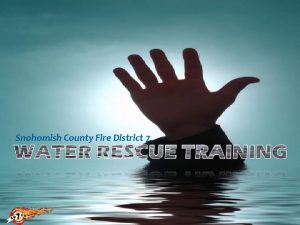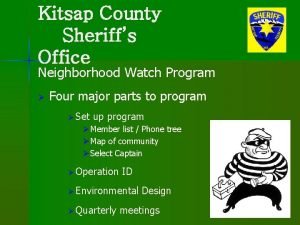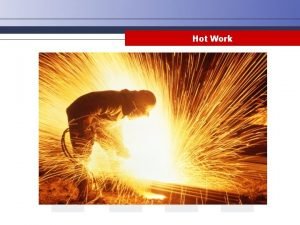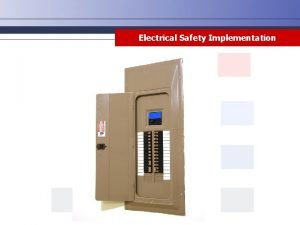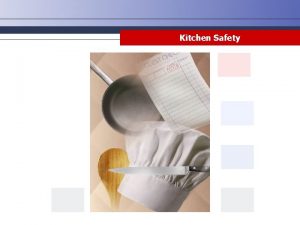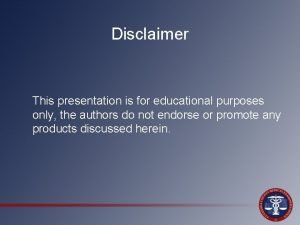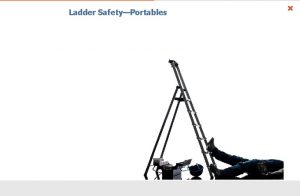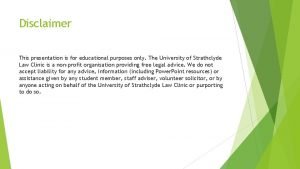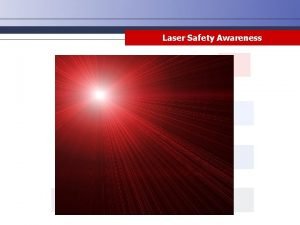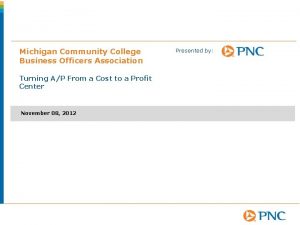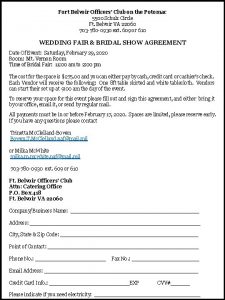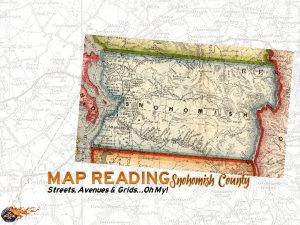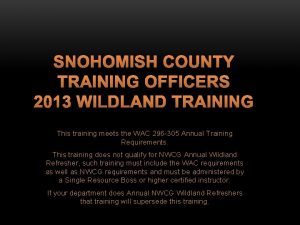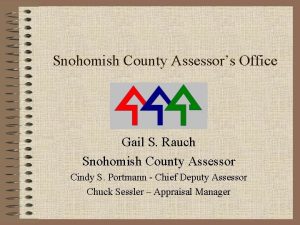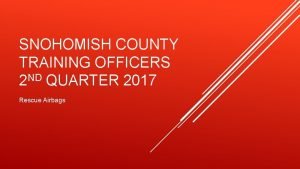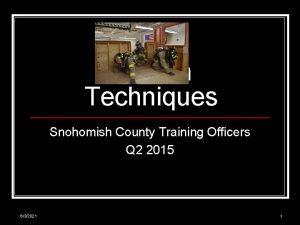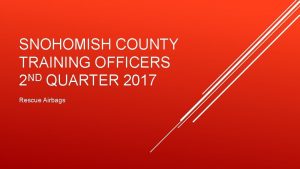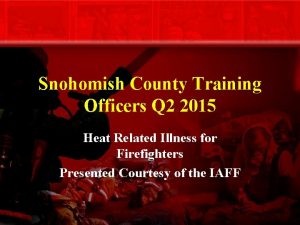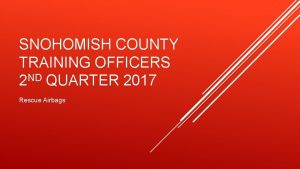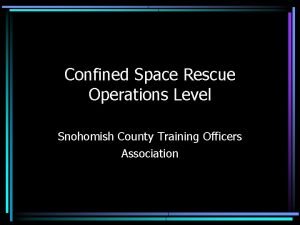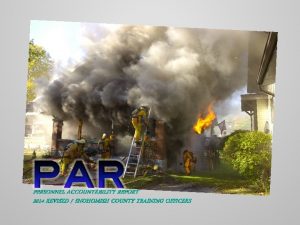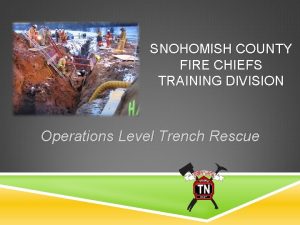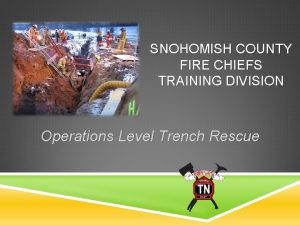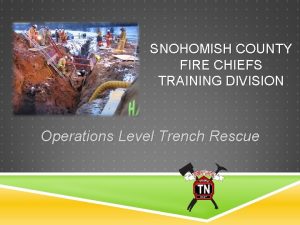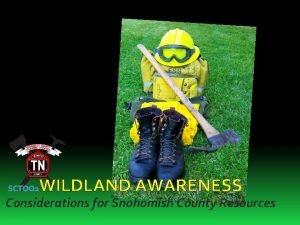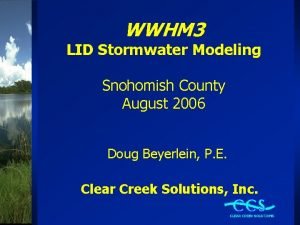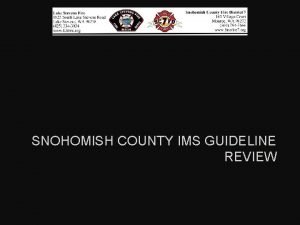Snohomish County Training Officers 2012 Q 2 Disclaimer






















- Slides: 22

Snohomish County Training Officers 2012 Q 2

Disclaimer The Snohomish County Training Officers realize not all fire departments in the county utilize or staff a ladder company on a regular basis. This presentation was developed to outline specific tasks performed on the fireground known as “truck work. ” It is not the intent of the Snohomish County Training Officers to insinuate this work can only be performed by ladder companies. Rather, it’s our hope you’ll better understand how these operations can have a positive impact on the fireground.

History “Hook-and-ladder companies first appeared back in colonial times, when their function was largely that of providing ladders for rescue of building occupants and application of water. As firefighting became more sophisticated, the hook-and-ladder men were assigned to force entry, open concealed spaces, and overhaul burned materials. It was not until about 200 years after the advent of hose lines that the next major change in strategy – theory of ventilation – was accepted. When it was, it, too, was assigned to the hook-and-ladder companies, and ventilation became one of their most important duties. ” Clark, W. E. (1991). Firefighting Principles & Practices. Saddle Brook, NJ: Fire Engineering Books & Videos.

Truck Company Operations “Truck Company Operations” or “Truck Work” are general terms for a type of work or functions performed on the fireground to support a coordinated fire attack.

Truck Company Operations Since they are performed in support of the rescue and fire suppression efforts, these functions are commonly known as fireground support operations. However, considering that properly performed fireground support operations can and often do prevent or reduce the loss of life in working structure fires, the term support should not be taken to mean “subordinate to” or “less important than” the fire suppression operations. In fact, they are as critical as any other fireground function.

Truck Company Operations Most metropolitan fire departments in North America, have staffed ladder companies to perform fireground support operations. Most have had staffed ladder companies in their departments for well over a century. It’s part of their culture and tradition. However, most fire departments in North America do not have the funding or the call volume to support dedicated staff on a ladder truck. In most cases, the training level of personnel and equipment carried by a department is all that is needed to successfully perform fireground support operations.

County’s Definition – Ladder Company SNOPAC Fire Radio Procedure Manual defines a ladder company as: Ladder [L] - (hydraulic straight ladder, platform, articulating boom, ladder platform) A fire attack vehicle equipped with an aerial device of 65 feet or taller. Meeting specifications as outlined in NFPA 1901 Chapter 6. Staffed with a minimum of three personnel trained in the use of the apparatus and its equipment. This vehicle does not have pumping capability. Ladder (with a pump) [LE] – Meets [the] requirement Ladder as outlined but in addition has [a] booster tank and pump making it capable of serving as an Engine. Often referred to as a Quint.

Fireground Support Operations No matter if a ladder company is on the scene or not, the functions and responsibilities for fireground support operations will still need to be addressed. All firefighters should be proficient at the skills involved in fireground support operations. Traditional ladder companies typically operate in teams of two. The incident will dictate function of all working together or splitting up into teams. Usually, teams are identified by function and/or location on the fireground, such as Inside and Outside Team. Tool assignments are designed to personnel and may be based on: Part of a pre-incident plan Tool location on the apparatus Riding location of the personnel

Tool & Job Assignments The tool & job assignments shown here an example of how fire district 7 has assigned tasks. Each department should assign tool & job assignments that fit the need of their agency.

Inside Team A team of firefighters consisting of the company officer and a firefighter who are responsible for the task assignments that need to be completed inside the building. This inside team is responsible forcible entry, search & rescue, assessing fire extension, and salvage operations. Typical tools: TIC Irons Pressurized Water Can (PWC) Hook Salvage Covers

Outside Team A team of firefighters consisting of the Driver Operator (D/O) and a firefighter who are responsible for the task assignments that need to be completed outside the building. The outside team is responsible for aerial operations, laddering, ventilation, firefighter egress routes, lighting, securing utilities, and supporting the Inside Team. When staffing does not support a complete outside team, the outside team responsibilities are assumed by the D/O alone (excluding vertical ventilation operations). Typical tools: Ladders Irons Saws (ventilation / forcible entry) Hooks Axes

Fireground Support Functions Ladders Forcible Entry Additional Egress – “Softening the Structure” Ventilation Search Location of fire Victims Rescue / VES Salvage Overhaul Utilities Additional Functions (requiring aerial device): Aerial Rescue Elevated Master Stream

Ladders Single company can usually handle this task. Typically conducted by the Outside Team member(s). Used for: Access Rescue Additional egress Ventilation

Forcible Entry / Egress Single or multiple companies needed depending on size of structure. If access is needed, typically conducted by the Inside Team members. Note: Most often the initial forcible entry is completed by the first arriving apparatus. “Softening the Structure” handled by the Outside Team member(s) or single resource. Forcible entry needed for: Access Search operations Additional egress – “Softening the Structure”

Ventilation - Horizontal Typically assigned to the Outside Team member(s). Shall coordinate with attack team. Horizontal 1 or 2 members PPV 1 or 2 members Tools: Ladders Hooks Fan

Ventilation - Vertical Residential Single company… 2 -3 members. Commercial Single to multiple companies needed. Defensive strip cut…consider multiple companies and/or ventilation group. Tools: Ladders Saws Hooks Axes

Search Single company… 2 -3 members for single-family residence. Multiple companies most likely needed for multi-family dwellings. Inside Team function if pre-assigned. Tools: TIC Irons PWC

Rescue / VES Single company for the initial VES tactic. Consider multiple companies for a confirmed rescue. Multiple companies most likely needed for multi -family dwellings. Outside Team function if pre-assigned. Tools: Ladders Hooks TIC

Utilities Typically assigned to an Outside Team member. A D/O or another single member can easily complete this task as long as it is not in an IDLH environment. Priorities Electrical Gas Tools: Channel Locks® / Vice-Grips®

Company Discussion What are your agency’s pre-assignments with regard to tools and activities on the fireground? Discuss the priorities of fireground support functions relative to: Room and contents fire in a single-story residential structure with everyone reported out of the building. Fully-Involved apartment unit on the top floor of a twostory multi-family dwelling at 0200 hrs.

Reference List Clark, W. E. (1991). Firefighting Principles & Practices. Saddle Brook, NJ: Fire Engineering Books & Videos. Fried, E. (1972). Fireground Tactics. Chicago, IL: H. Marvin Ginn Corp. Goodson, C. (2002). Fireground Support Operations. Stillwater, OK: Fire Protection Publications, Oklahoma State University. Mittendorf, J. (1998). Truck Company Operations. Saddle Brook, NJ: Fire Engineering Books & Videos. Norman, J. (2005). Fire Officer’s Handbook of Tactics (3 rd ed. ). Tulsa, OK: Penn. Well Corporation. Snohomish County Fire District #7 (2003). 3 -48 Tool and Job Task Assignments – Ladder Company (rev. June 2011). SNOPAC (2009). Fire Radio Procedures Manual.

 Coordinated entry snohomish county
Coordinated entry snohomish county Snohomish county sheriff south precinct
Snohomish county sheriff south precinct Snohomish county fire district 7
Snohomish county fire district 7 Kitsap crime watch
Kitsap crime watch Training officers consortium
Training officers consortium Snohomish naturopathic clinic
Snohomish naturopathic clinic Disclaimer for training material
Disclaimer for training material Disclaimer for training material
Disclaimer for training material Disclaimer for training material
Disclaimer for training material Illustrative purposes only disclaimer
Illustrative purposes only disclaimer Ladder types ratings
Ladder types ratings Educational purposes disclaimer
Educational purposes disclaimer Disclaimer for training material
Disclaimer for training material Bel retired employees medical scheme
Bel retired employees medical scheme Community college business officers
Community college business officers Fort belvoir officers club
Fort belvoir officers club Ccccio conference
Ccccio conference California community college chief instructional officers
California community college chief instructional officers International foundation for protection officers
International foundation for protection officers Uk chief medical officers' physical activity guidelines
Uk chief medical officers' physical activity guidelines 36 officers problem
36 officers problem Police officer's pledge
Police officer's pledge Tell tale heart annotations
Tell tale heart annotations


